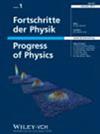求助PDF
{"title":"希格斯膨胀和电弱测量部门","authors":"Stephon Alexander, Cyril Creque-Sarbinowski, Humberto Gilmer, Katherine Freese","doi":"10.1002/prop.202500020","DOIUrl":null,"url":null,"abstract":"<p>We introduce a method that allows the Higgs to be the inflaton. The Higgs is considered as a pseudo-Nambu-Goldstone (pNG) boson of a global coset symmetry <span></span><math>\n <semantics>\n <mrow>\n <mi>G</mi>\n <mo>/</mo>\n <mi>H</mi>\n </mrow>\n <annotation>$G/H$</annotation>\n </semantics></math>, which is spontaneously breaks at an energy scale <span></span><math>\n <semantics>\n <mrow>\n <mo>∼</mo>\n <mn>4</mn>\n <mi>π</mi>\n <mi>f</mi>\n </mrow>\n <annotation>$\\sim 4\\pi f$</annotation>\n </semantics></math>. A suitable <span></span><math>\n <semantics>\n <mrow>\n <mi>S</mi>\n <mi>U</mi>\n <mo>(</mo>\n <mn>2</mn>\n <mo>)</mo>\n <mo>⊂</mo>\n <mi>G</mi>\n </mrow>\n <annotation>$SU(2) \\subset G$</annotation>\n </semantics></math> Chern−Simons (CS) interaction is given to it, with <span></span><math>\n <semantics>\n <mi>β</mi>\n <annotation>$\\beta$</annotation>\n </semantics></math> representing the dimensionless CS coupling strength and <span></span><math>\n <semantics>\n <mi>f</mi>\n <annotation>$f$</annotation>\n </semantics></math> an <span></span><math>\n <semantics>\n <mrow>\n <mi>S</mi>\n <mi>U</mi>\n <mo>(</mo>\n <mn>2</mn>\n <mo>)</mo>\n </mrow>\n <annotation>$SU(2)$</annotation>\n </semantics></math> decay constant. As a result, slow-roll inflation occurs via <span></span><math>\n <semantics>\n <mrow>\n <mi>S</mi>\n <mi>U</mi>\n <mo>(</mo>\n <mn>2</mn>\n <mo>)</mo>\n </mrow>\n <annotation>$SU(2)$</annotation>\n </semantics></math>-induced friction down a steep sinusoidal potential. To obey electroweak <span></span><math>\n <semantics>\n <mrow>\n <mi>S</mi>\n <mi>U</mi>\n <msub>\n <mrow>\n <mo>(</mo>\n <mn>2</mn>\n <mo>)</mo>\n </mrow>\n <mi>L</mi>\n </msub>\n <mo>×</mo>\n <mi>U</mi>\n <msub>\n <mrow>\n <mo>(</mo>\n <mn>1</mn>\n <mo>)</mo>\n </mrow>\n <mi>Y</mi>\n </msub>\n </mrow>\n <annotation>$SU(2)_{\\rm L}\\times U(1)_Y$</annotation>\n </semantics></math> symmetry, the lowest-order CS interaction is required to be quadratic in the Higgs, with the coupling strength <span></span><math>\n <semantics>\n <mrow>\n <mo>∝</mo>\n <msup>\n <mi>β</mi>\n <mn>2</mn>\n </msup>\n <mo>/</mo>\n <msup>\n <mi>f</mi>\n <mn>2</mn>\n </msup>\n </mrow>\n <annotation>$\\propto \\beta ^2/f^2$</annotation>\n </semantics></math>. Higher-order interaction terms keep the full Lagrangian nearly invariant under the approximate pNG shift symmetry. Employing the simplest symmetry coset <span></span><math>\n <semantics>\n <mrow>\n <mi>S</mi>\n <mi>U</mi>\n <mo>(</mo>\n <mn>5</mn>\n <mo>)</mo>\n <mo>/</mo>\n <mi>S</mi>\n <mi>O</mi>\n <mo>(</mo>\n <mn>5</mn>\n <mo>)</mo>\n </mrow>\n <annotation>$SU(5)/SO(5)$</annotation>\n </semantics></math>, <span></span><math>\n <semantics>\n <mi>N</mi>\n <annotation>$N$</annotation>\n </semantics></math> <span></span><math>\n <semantics>\n <mi>e</mi>\n <annotation>$e$</annotation>\n </semantics></math>-folds of inflation occur when <span></span><math>\n <semantics>\n <mrow>\n <mi>N</mi>\n <mo>≈</mo>\n <mn>60</mn>\n <msup>\n <mfenced>\n <mi>g</mi>\n <mo>/</mo>\n <mn>0.64</mn>\n </mfenced>\n <mn>2</mn>\n </msup>\n <msup>\n <mfenced>\n <mi>β</mi>\n <mo>/</mo>\n <mfenced>\n <mn>3</mn>\n <mo>×</mo>\n <msup>\n <mn>10</mn>\n <mn>6</mn>\n </msup>\n </mfenced>\n </mfenced>\n <mrow>\n <mn>8</mn>\n <mo>/</mo>\n <mn>3</mn>\n </mrow>\n </msup>\n <msup>\n <mfenced>\n <mi>f</mi>\n <mo>/</mo>\n <mfenced>\n <mn>5</mn>\n <mo>×</mo>\n <msup>\n <mn>10</mn>\n <mn>11</mn>\n </msup>\n <mspace></mspace>\n <mi>GeV</mi>\n </mfenced>\n </mfenced>\n <mrow>\n <mn>2</mn>\n <mo>/</mo>\n <mn>3</mn>\n </mrow>\n </msup>\n </mrow>\n <annotation>$N \\approx 60 \\left(g/0.64\\right)^2\\left[\\beta /\\left(3\\times 10^6\\right)\\right]^{8/3}\\left[f/\\left(5\\times 10^{11}\\ {\\rm GeV}\\right)\\right]^{2/3}$</annotation>\n </semantics></math>. Successfully explaining inflation necessitates small values of the decay constant, <span></span><math>\n <semantics>\n <mrow>\n <mi>f</mi>\n <mo>≲</mo>\n <mn>5</mn>\n <mo>×</mo>\n <msup>\n <mn>10</mn>\n <mn>11</mn>\n </msup>\n <mi>GeV</mi>\n </mrow>\n <annotation>$f \\lesssim 5 \\times 10^{11} {\\rm GeV}$</annotation>\n </semantics></math>; this in turn requires large <span></span><math>\n <semantics>\n <mi>β</mi>\n <annotation>$\\beta$</annotation>\n </semantics></math>, which is ruled out by electric dipole measurements. Although the electroweak hierarchy problem while achieving successful inflation, the real benefit is found in providing a different path to identifying the Higgs as the inflaton, outside the standard modified-gravity framework.</p>","PeriodicalId":55150,"journal":{"name":"Fortschritte Der Physik-Progress of Physics","volume":"73 5","pages":""},"PeriodicalIF":7.8000,"publicationDate":"2025-03-01","publicationTypes":"Journal Article","fieldsOfStudy":null,"isOpenAccess":false,"openAccessPdf":"","citationCount":"0","resultStr":"{\"title\":\"Higgs Inflation and the Electroweak Gauge Sector\",\"authors\":\"Stephon Alexander, Cyril Creque-Sarbinowski, Humberto Gilmer, Katherine Freese\",\"doi\":\"10.1002/prop.202500020\",\"DOIUrl\":null,\"url\":null,\"abstract\":\"<p>We introduce a method that allows the Higgs to be the inflaton. The Higgs is considered as a pseudo-Nambu-Goldstone (pNG) boson of a global coset symmetry <span></span><math>\\n <semantics>\\n <mrow>\\n <mi>G</mi>\\n <mo>/</mo>\\n <mi>H</mi>\\n </mrow>\\n <annotation>$G/H$</annotation>\\n </semantics></math>, which is spontaneously breaks at an energy scale <span></span><math>\\n <semantics>\\n <mrow>\\n <mo>∼</mo>\\n <mn>4</mn>\\n <mi>π</mi>\\n <mi>f</mi>\\n </mrow>\\n <annotation>$\\\\sim 4\\\\pi f$</annotation>\\n </semantics></math>. A suitable <span></span><math>\\n <semantics>\\n <mrow>\\n <mi>S</mi>\\n <mi>U</mi>\\n <mo>(</mo>\\n <mn>2</mn>\\n <mo>)</mo>\\n <mo>⊂</mo>\\n <mi>G</mi>\\n </mrow>\\n <annotation>$SU(2) \\\\subset G$</annotation>\\n </semantics></math> Chern−Simons (CS) interaction is given to it, with <span></span><math>\\n <semantics>\\n <mi>β</mi>\\n <annotation>$\\\\beta$</annotation>\\n </semantics></math> representing the dimensionless CS coupling strength and <span></span><math>\\n <semantics>\\n <mi>f</mi>\\n <annotation>$f$</annotation>\\n </semantics></math> an <span></span><math>\\n <semantics>\\n <mrow>\\n <mi>S</mi>\\n <mi>U</mi>\\n <mo>(</mo>\\n <mn>2</mn>\\n <mo>)</mo>\\n </mrow>\\n <annotation>$SU(2)$</annotation>\\n </semantics></math> decay constant. As a result, slow-roll inflation occurs via <span></span><math>\\n <semantics>\\n <mrow>\\n <mi>S</mi>\\n <mi>U</mi>\\n <mo>(</mo>\\n <mn>2</mn>\\n <mo>)</mo>\\n </mrow>\\n <annotation>$SU(2)$</annotation>\\n </semantics></math>-induced friction down a steep sinusoidal potential. To obey electroweak <span></span><math>\\n <semantics>\\n <mrow>\\n <mi>S</mi>\\n <mi>U</mi>\\n <msub>\\n <mrow>\\n <mo>(</mo>\\n <mn>2</mn>\\n <mo>)</mo>\\n </mrow>\\n <mi>L</mi>\\n </msub>\\n <mo>×</mo>\\n <mi>U</mi>\\n <msub>\\n <mrow>\\n <mo>(</mo>\\n <mn>1</mn>\\n <mo>)</mo>\\n </mrow>\\n <mi>Y</mi>\\n </msub>\\n </mrow>\\n <annotation>$SU(2)_{\\\\rm L}\\\\times U(1)_Y$</annotation>\\n </semantics></math> symmetry, the lowest-order CS interaction is required to be quadratic in the Higgs, with the coupling strength <span></span><math>\\n <semantics>\\n <mrow>\\n <mo>∝</mo>\\n <msup>\\n <mi>β</mi>\\n <mn>2</mn>\\n </msup>\\n <mo>/</mo>\\n <msup>\\n <mi>f</mi>\\n <mn>2</mn>\\n </msup>\\n </mrow>\\n <annotation>$\\\\propto \\\\beta ^2/f^2$</annotation>\\n </semantics></math>. Higher-order interaction terms keep the full Lagrangian nearly invariant under the approximate pNG shift symmetry. Employing the simplest symmetry coset <span></span><math>\\n <semantics>\\n <mrow>\\n <mi>S</mi>\\n <mi>U</mi>\\n <mo>(</mo>\\n <mn>5</mn>\\n <mo>)</mo>\\n <mo>/</mo>\\n <mi>S</mi>\\n <mi>O</mi>\\n <mo>(</mo>\\n <mn>5</mn>\\n <mo>)</mo>\\n </mrow>\\n <annotation>$SU(5)/SO(5)$</annotation>\\n </semantics></math>, <span></span><math>\\n <semantics>\\n <mi>N</mi>\\n <annotation>$N$</annotation>\\n </semantics></math> <span></span><math>\\n <semantics>\\n <mi>e</mi>\\n <annotation>$e$</annotation>\\n </semantics></math>-folds of inflation occur when <span></span><math>\\n <semantics>\\n <mrow>\\n <mi>N</mi>\\n <mo>≈</mo>\\n <mn>60</mn>\\n <msup>\\n <mfenced>\\n <mi>g</mi>\\n <mo>/</mo>\\n <mn>0.64</mn>\\n </mfenced>\\n <mn>2</mn>\\n </msup>\\n <msup>\\n <mfenced>\\n <mi>β</mi>\\n <mo>/</mo>\\n <mfenced>\\n <mn>3</mn>\\n <mo>×</mo>\\n <msup>\\n <mn>10</mn>\\n <mn>6</mn>\\n </msup>\\n </mfenced>\\n </mfenced>\\n <mrow>\\n <mn>8</mn>\\n <mo>/</mo>\\n <mn>3</mn>\\n </mrow>\\n </msup>\\n <msup>\\n <mfenced>\\n <mi>f</mi>\\n <mo>/</mo>\\n <mfenced>\\n <mn>5</mn>\\n <mo>×</mo>\\n <msup>\\n <mn>10</mn>\\n <mn>11</mn>\\n </msup>\\n <mspace></mspace>\\n <mi>GeV</mi>\\n </mfenced>\\n </mfenced>\\n <mrow>\\n <mn>2</mn>\\n <mo>/</mo>\\n <mn>3</mn>\\n </mrow>\\n </msup>\\n </mrow>\\n <annotation>$N \\\\approx 60 \\\\left(g/0.64\\\\right)^2\\\\left[\\\\beta /\\\\left(3\\\\times 10^6\\\\right)\\\\right]^{8/3}\\\\left[f/\\\\left(5\\\\times 10^{11}\\\\ {\\\\rm GeV}\\\\right)\\\\right]^{2/3}$</annotation>\\n </semantics></math>. Successfully explaining inflation necessitates small values of the decay constant, <span></span><math>\\n <semantics>\\n <mrow>\\n <mi>f</mi>\\n <mo>≲</mo>\\n <mn>5</mn>\\n <mo>×</mo>\\n <msup>\\n <mn>10</mn>\\n <mn>11</mn>\\n </msup>\\n <mi>GeV</mi>\\n </mrow>\\n <annotation>$f \\\\lesssim 5 \\\\times 10^{11} {\\\\rm GeV}$</annotation>\\n </semantics></math>; this in turn requires large <span></span><math>\\n <semantics>\\n <mi>β</mi>\\n <annotation>$\\\\beta$</annotation>\\n </semantics></math>, which is ruled out by electric dipole measurements. Although the electroweak hierarchy problem while achieving successful inflation, the real benefit is found in providing a different path to identifying the Higgs as the inflaton, outside the standard modified-gravity framework.</p>\",\"PeriodicalId\":55150,\"journal\":{\"name\":\"Fortschritte Der Physik-Progress of Physics\",\"volume\":\"73 5\",\"pages\":\"\"},\"PeriodicalIF\":7.8000,\"publicationDate\":\"2025-03-01\",\"publicationTypes\":\"Journal Article\",\"fieldsOfStudy\":null,\"isOpenAccess\":false,\"openAccessPdf\":\"\",\"citationCount\":\"0\",\"resultStr\":null,\"platform\":\"Semanticscholar\",\"paperid\":null,\"PeriodicalName\":\"Fortschritte Der Physik-Progress of Physics\",\"FirstCategoryId\":\"101\",\"ListUrlMain\":\"https://onlinelibrary.wiley.com/doi/10.1002/prop.202500020\",\"RegionNum\":3,\"RegionCategory\":\"物理与天体物理\",\"ArticlePicture\":[],\"TitleCN\":null,\"AbstractTextCN\":null,\"PMCID\":null,\"EPubDate\":\"\",\"PubModel\":\"\",\"JCR\":\"Q1\",\"JCRName\":\"PHYSICS, MULTIDISCIPLINARY\",\"Score\":null,\"Total\":0}","platform":"Semanticscholar","paperid":null,"PeriodicalName":"Fortschritte Der Physik-Progress of Physics","FirstCategoryId":"101","ListUrlMain":"https://onlinelibrary.wiley.com/doi/10.1002/prop.202500020","RegionNum":3,"RegionCategory":"物理与天体物理","ArticlePicture":[],"TitleCN":null,"AbstractTextCN":null,"PMCID":null,"EPubDate":"","PubModel":"","JCR":"Q1","JCRName":"PHYSICS, MULTIDISCIPLINARY","Score":null,"Total":0}
引用次数: 0
引用
批量引用

 求助内容:
求助内容: 应助结果提醒方式:
应助结果提醒方式:


